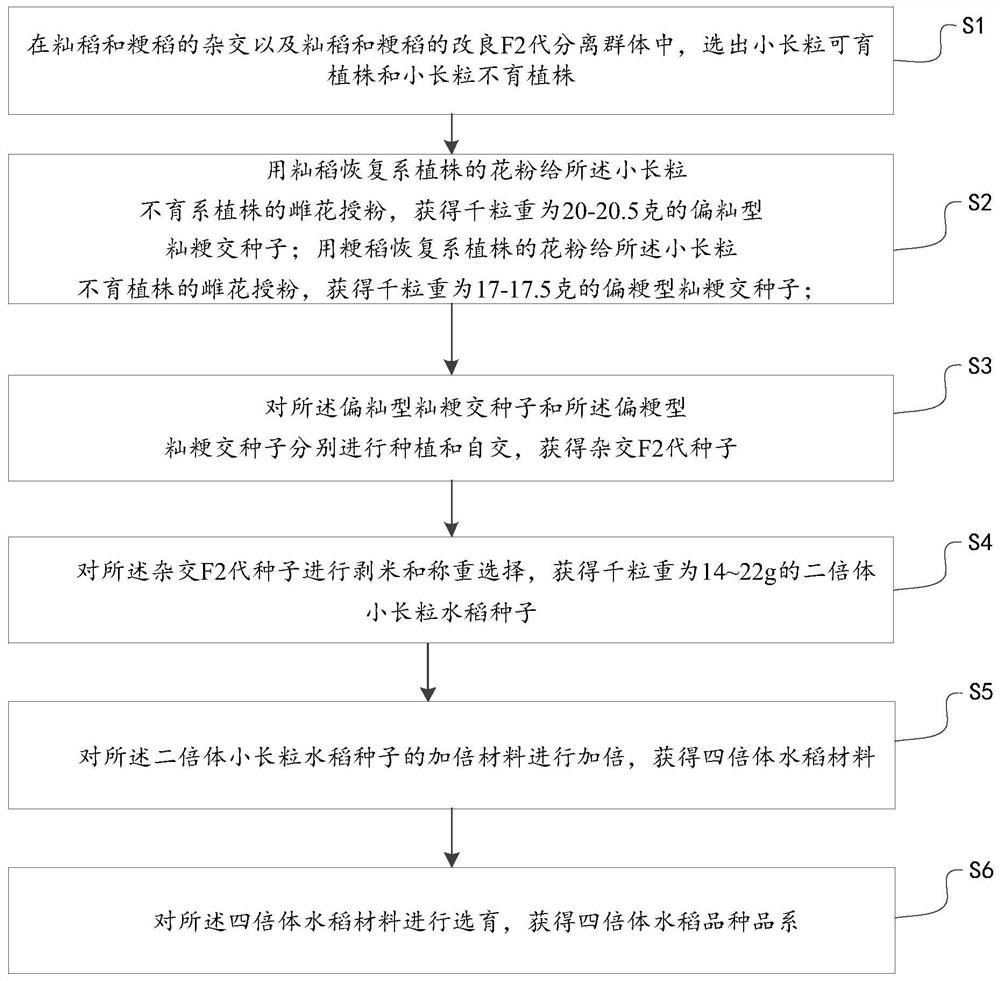Tetraploid rice breeding method
A tetraploid and rice seed technology, applied in the field of agricultural breeding, can solve the problems of small number of grains per panicle, low yield per unit area, and few effective panicles
- Summary
- Abstract
- Description
- Claims
- Application Information
AI Technical Summary
Problems solved by technology
Method used
Image
Examples
Embodiment approach
[0060] The said hybrid F2 generation seeds are stripped and weighed for selection, comprising:
[0061] Using the pollen of the small long-grain fertile plant to pollinate the female flower of the small long-grain sterile plant to obtain artificial backcross BC1 generation seeds with a thousand-grain weight of 15-15.5 grams and an aspect ratio > 3;
[0062] Planting the artificial backcross BC1 generation seeds to obtain backcross BC2 generation seeds;
[0063] Selfing the small long-grain fertile plant to obtain selfed S1 generation seeds with a thousand-grain weight of 16.5-17.0 grams and an aspect ratio > 3;
[0064] Planting and selfing the self-bred S1 generation seeds to obtain self-bred S2 generation seeds;
[0065] Rice peeling and weighing selection were performed on the backcross BC2 generation seeds, the self-crossing S2 generation seeds and the hybrid F2 generation seeds.
[0066] As an implementation manner of the embodiment of the present invention, the doublin...
Embodiment 1
[0079] On August 20, 2016, at the Xiangyang base, a small long-grained sterile plant was found in the F2 generation segregation population of cultivated rice subspecies (indica-japonica cross) in the selection nursery. Long-grained fertile plants. Then the male flowers of the fertile plants were used to pollinate the female flowers of the sterile plants to obtain backcross BC1 generation seeds; at the same time, an excellent indica rice restorer line containing blast resistance gene and an excellent japonica rice restorer line containing blast resistance gene were selected respectively The female flowers of the sterile plants were pollinated, and after fertilization and maturity, two hybrid F1 seeds, the indica-japonica hybrid seeds and the japonica-type indica-japonica hybrid seeds, were harvested; and the fertile plants were selfed to obtain selfed S1 seeds. Among them, the thousand-grain weight of the hybrid seeds obtained by pollinating the sterile plants with the indica r...
Embodiment 2
[0093] At the beginning of May, 2017, 20 parts of plant seeds were selected from the remaining 270 parts of plant seeds after 30 parts of plant seeds were screened out from Example 1, and 20 parts of plant seeds were selected for processing, and the seed dormancy (post-ripening effect) was broken by freezing, and the treatment time was 15 days. After the dormancy is broken, the seeds have good permeability, strong water absorption and high germination rate.
[0094] On May 16, 2017, the seeds of 20 plants that broke dormancy will be soaked to accelerate germination and planted in the field. By July 20, the young ears of the planted plants will be harvested when they have developed to the 3-4 stage, and the second double material will be obtained. .
[0095] From July 20th to 30th, 2017, the second doubling material was sent to the laboratory in 3 batches for doubling the young ears, and tetraploid material was obtained.
[0096] The doubling method is as follows: young ears a...
PUM
 Login to View More
Login to View More Abstract
Description
Claims
Application Information
 Login to View More
Login to View More - R&D
- Intellectual Property
- Life Sciences
- Materials
- Tech Scout
- Unparalleled Data Quality
- Higher Quality Content
- 60% Fewer Hallucinations
Browse by: Latest US Patents, China's latest patents, Technical Efficacy Thesaurus, Application Domain, Technology Topic, Popular Technical Reports.
© 2025 PatSnap. All rights reserved.Legal|Privacy policy|Modern Slavery Act Transparency Statement|Sitemap|About US| Contact US: help@patsnap.com

